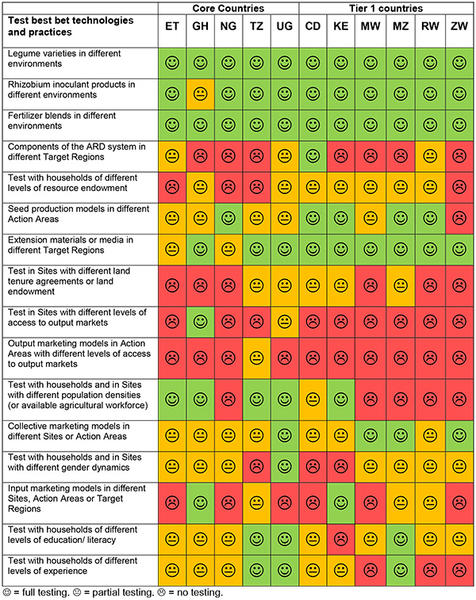N2Africa is scaling-out grain legume technologies, practices and models to benefit smallholder farmers in multiple, diverse and heterogeneous contexts of sub-Saharan Africa. This scaling-out process benefits from our understanding of the factors that affect adoption of grain legumes and how those factors vary across different contexts. Our understanding of how factors change in different contexts allows us to select the best bets for a particular context. These best bets are then tested and adapted and the best fit grain legume technologies and practices are adopted.
In N2Africa we manage adoption factors by: (i) mapping and characterizing the countries where we work to defined adoption domains; (ii) choosing Action Areas and activity sites that are representative of different adoption domains, and; (iii) testing and evaluating the performance of different grain legume technologies and practices in different domains.
We have recently evaluated the implementation of our design in all N2Africa countries. We saw that the selection of Action Areas and activity sites was partially influenced by the adoption domains, but that there were competing criteria – such as the location of partners, or new opportunities.
|
More specifically, we observed that grain legume species have been targeted for multiple biophysical environments in sub-Saharan Africa, and within countries. Rhizobium inoculant and legume specific fertilizer blends have also been targeted to specific contexts, although not in all countries. Relatively fewer input and output marketing models have been tested due to the public private partnerships, which are a key mechanism for dissemination in the N2Africa project (Table 1). Testing technologies among households with different resource endowments, gender dynamics, experience, and education levels has occurred, but this has tended to be serendipitous rather than targeted. Assessing the impact of our targeting is difficult, because there are no obvious counterfactual cases with which to compare the N2Africa countries, Action Areas, sites and households. Furthermore, in N2Africa we cannot claim adoption whilst the project is actively promoting the technology so we are currently unable to assess the impact of the targeting in terms of adoption. But the initial evaluation presented here is an important first step towards explaining how context affects best bets and leads to adoption of best fit technologies, practices and approaches. |
Table 1. Operationalisation of N2Africa research design to manage factors affecting adoption of grain legume technologies and practices  |
Andrew Farrow, GeAgrofía, Wageningen
